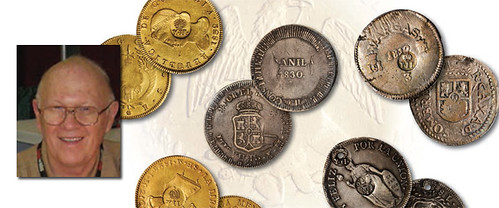
PREV ARTICLE
NEXT ARTICLE
FULL ISSUE
PREV FULL ISSUE
THE CZAHOR COLLECTION OF PHILIPPINES COUNTERMARKSA "Meet the Consignor" article on the Stack's Bowers blog this week profiled Ray Czahor and his collection of rare
Philippines countermarks. -Editor
 Ray started collecting coins and stamps in the early 1950s. After collecting over 5,500 world stamps, he quickly realized he hadn’t even scratched the surface, and traded all his stamps, albums, and catalogs to a couple for their United States coin collection. To this day, he has maintained his interest in U.S. type sets, Buffalo nickels, Standing Liberty quarters, Walking Liberty halves and U.S. currency. His interest in Philippine numismatics began when he was stationed there in 1963, while a newly minted 2nd lieutenant in the United States Air Force. He was fascinated with the history of the Philippines as it moved from Spanish rule through the United States’ administration to the Philippine Republic. He was interested in the governments’ varied impact on coins, tokens, medals and currency, including during the Japanese Occupation and Guerilla/Emergency notes. All areas of Philippine coinage had collectible interest for Ray, including the trials, patterns, varieties and low mintages that enhance the challenge of Philippine numismatics. Currently, Ray distributes an annual mail bid covering World War II books and all aspects of Philippine numismatics. He can be reached at cookiejarpi@verizon.net. Ray purchased his first Philippine counterstamp in 1964, an 1835 Y.II C/S on an 1754 Mexican 8 Reales coin for $50 (not offered in the sale but part of his Philippine type set). He knew Pillar coins were very collectible, but with a Philippine counterstamp — wow! That purchase initiated his research into the history of these interesting coins, but little information was available in the Philippines. After returning to the United States in 1965, he found articles by Dr. P.I. DeJesus who listed several types of counterstamps. Ray began to search through dealer lists and at tables at coin shows and slowly added a few pieces to his collection. But it wasn’t until the mid- 1980s that significant and new information was provided by Frank F. Gilboy, in an article in the June 1984 issue of the Barrilla, official publication of the Philippine Central Bank Money Museum. In the article, Mr. Gilboy explained how to date the individual counterstamps by examining the number of pearls in sequence in the crown of the counterstamp. From his examination of a number of examples, Mr. Gilboy was able to estimate the percentages of counterstamp strikings of each date. Ray’s experience generally supports Mr. Gilboy’s estimates of the relative rarity of the date of the counterstamp. This energized Ray’s interest to find the scarcer dated counterstamps, and to start looking for them on rarer country host coins, varieties or overdated host coins, and particularly to search for higher grade host coins and counterstamps. Some countries such as Peru and Mexico provided many examples, but finding the coin and the counterstamp in VF to AU was the challenge! Ray included a note about the consignment in an email Tuesday. -Editor
Ray writes: My reference collection of Philippine Manila, F.7o and Y.II. Counterstamps will be auctioned By Stacks in their upcoming NY International Auction on the 10th of January 2015 at the Waldorf Astoria. Many of these are absolutely RARE (including those on GOLD) and have not been on the market in years. One hundred different counterstamps are in the auction (all are encapsulated), starting with Lot 1358. Also don¹t forget to look at additional counterstamps starting at Lot 4198 in the Internet auction that probably will go quite cheaply so look for bargains there. Kyle Ponterio did an outstanding job of researching and providing lots of details on each counterstamp so review his list of references plus the table of how to date counterstamps at the beginning of the catalog. To read the complete article, see:
Wayne Homren, Editor The Numismatic Bibliomania Society is a non-profit organization promoting numismatic literature. See our web site at coinbooks.org. To submit items for publication in The E-Sylum, write to the Editor at this address: whomren@gmail.com To subscribe go to: https://my.binhost.com/lists/listinfo/esylum All Rights Reserved. NBS Home Page Contact the NBS webmaster 
|